It has been some time since I last wrote the last article of this blog, and my year travelling is now coming to an end. I’m now back on dry land in Europe, after another (excellent) 2 week journey back by cargo ship from Central America. I am hitch-hiking and couch-surfing to get back to England, but I will now be back in just a few days.
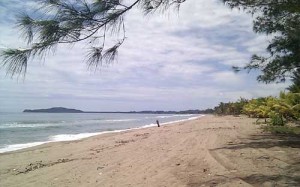
The North coast of Honduras is sprinkled with beautiful beaches, and Triunfo has an amazing one – unfortunately, to developers this appears to makes the land more valuable than the people living there
The last time I wrote, it was about COPINH – the Indigenous Rights organisation in the West of Honduras, and the recent arrest of their coordinator Berta Cáceres, in an attempt to criminalise their struggle. Thank you to all who responded to that article by looking deeper into COPINH or signing one of the online petitions against her trial. I can report that the huge amount of international pressure led to her case being temporarily thrown out of the court for lack of evidence. However, COPINH’s struggle continues in the face of repression – tragically on the 15th of July another COPINH activist Tomas Garcia – who I had also met on my visit – was assassinated by the Honduran military. This shocking turn demonstrates just how far the corrupt military will go to protect the interests of the dam project in the area. Anyone interested in this ongoing and brutal struggle can find more info on the COPINH website, here.
After visiting COPINH, I had 3 more weeks in Honduras visiting other social organisations and partners of ENCA. First, I had an excellent visit to the CAM – the Campamento area Environmental Movement, and saw the complexities of their struggle against illegal logging and environmental degradation in their area. Later I visited Fundación PROLANSATE in the North, an organisation that has been fighting for years – with impressive results – for legislation to regulate Honduran industry, and for the protection of the natural reserves that it manages. Unfortunately, space doesn’t allow me to go into all the work of these 2 very valuable organisations here.
Much of my time in Honduras was spent in the North coastal region of Honduras, whose beaches and Caribbean islands draw much of the country’s tourism. Against this backdrop, the area has a great diversity of different people – and just as wide a variety of fights against political and economic marginalisation. I visited 2 very different organisations there – OFRANEH and MOPAWI – that demonstrated this variety and showed me other sides to the Honduran struggles that I had first seen with COPINH.
OFRANEH and the Garifuna – “Triunfo vs. the Honduran State”
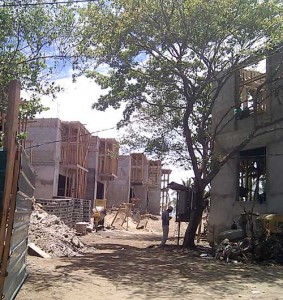
OFRANEH took me on a tour of tourism developments in Triunfo, including the contested contruction of these holiday apartments
OFRANEH is the Organisation of Black and Garifuna People of Honduras. The Garifuna are an indigenous group spread across the Caribbean coast and islands from Belize down to Nicaragua. They have an incredible and inspiring history since their origins with the mixing of escaped African slaves and indigenous Caribbeans, and war and social struggles against the British and other colonial powers since then. In Honduras, they are now fighting for land rights against increasing land grabbing, in particular for tourism and African palm plantations – 2 of the most significant current driving forces of exploitation and corruption in Honduras.
OFRANEH is one of the most vociferous organisations fighting these struggles for the Garifuna’s claims to land titles against these developments. I visited them in Triunfo, a Garifuna town in the Tela Bay area, an area currently being promoted for a massive tourism project with the stated aim of turning the area into the “Cancun of Honduras”. I had visited Cancun on my way through Mexico, and can say outright that the world doesn’t need another one. It is a centre of American hotel and restaurant chains, the Mexican population living in poorly maintained districts where councils are interested in reducing the quality of housing in order to sell the land for more hotels. This sort of development is always hailed as bringing in investment and creating jobs, but Honduras in particular lacks the regulatory framework to ensure that this sort of development doesn’t destroy the environment and livelihoods of the people there.
The people I met at OFRANEH had plenty of experience of promises of development and employment from tourism developers – and the reality of their land and livelihoods being destroyed, with only the meanest jobs being created for them. Alfredo Lopez, who organised my visit, was leading the Triunfo community in the 1st legal case so far to bring the Garifuna’s land claims to the Inter-American Court of Human Rights
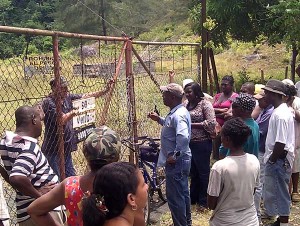
I attended a Triunfo community meeting on current land issues, after which a group of 30 Garifuna visited some of the contested sites, to take evidence for their court case. This site has been important for the community for the stones they use in their graveyard, but is now closed off and awaiting resale by its French owner.
– a case currently in process in Costa Rica. The “Triunfo vs. the Honduran State” trial is built of many personal cases of Garifuna who have sold their land to tourism developers, based on these empty promises. They are taking the state to court for failing to protect their rights as indigenous holders of the land. They argue that these land sales are illegal, as the Garifuna land is legally recognised communally owned “ancestral” land, and it is not supposed to be possible to sell it without permission from the community.
Like the Zapatistas in Mexico, OFRANEH recognise that dispossession of their land is the first step in losing their cultural and economic independence – rooted in their agricultural traditions. Without this, they are exposed to powerful big-businesses and exploitation that places very little value on them, and threatens to completely marginalise their existence. Also like the Zapatistas, they are now fighting to maintain the legal foundation of their land rights, established in their own country’s law decades ago but now being deliberately attacked by big business and the state in order to profit from their land.
The Mosquitia and MOPAWI – Bringing Basic Infrastructure and Economic Options to the Remotest of the Remote
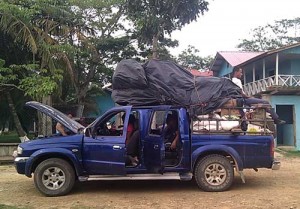
Just to get to MOPAWI involved riding break-neck hanging off the edge of a fully laden jeep – made even scarier when the jeeps actually need to drive into the sea!
After visiting the well-touristed Tela Bay area, my next destination took me east, into the remote Mosquitia coast. Here the road network peters out and disappears, to be replaced by wetlands navigable only by canoe, and inhabited by the Misquito indigenous groups – about as marginalised a group as you can find in Central America. I was invited to travel there with another ENCA contact, MOPAWI – which in Misquito stands for the Agency for the Development of the Mosquitia. Getting there was probably the most exhilarating journey of the whole year – it is 5 hours by jeep from the most Eastern urban centres of the coast to the start of the Mosquitia. During the journey the road network steadily vanishes – the last hour is spent racing along the beach, avoiding logs and tree branches and falling into the sea. This is made even scarier by the fact that the passengers have to spill over onto the back of the jeep, sitting on a pile of precariously strapped-together luggage. The jeep drops you where the river and canal network begins, and from there it was 1 hour by motorised canoe to Belén, where MOPAWI have their regional office.
I spent several days there, shown around by MOPAWI’s friendly representative Carlos Molinero, seeing several of their projects and meeting a lot of very interesting indigenous Misquito. The Mosquitia is a seriously underdeveloped area, lacking basic infrastructure like water and power supplies, sewers and so on. The Misquito people are also extremely marginalised economically – fishing and agriculture are the only 2 forms of livelihood and income they have ready access to, and both are under threat from environmental degradation. MOPAWI has various projects to tackle these problems – much of what I saw of their work was projects such as hygienic latrines to tackle sewage, and rain or well-fed drinking water systems. Carlos was able to show me progressive stages of the evolution of these projects. MOPAWI’s constant efforts to innovate and improve their projects was evident, as was the magnitude of the challenges they face in the isolated region.
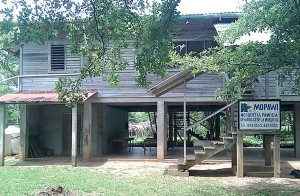
MOPAWI’s centre in Belén – Misquito houses are generally of wood, raised off the ground to avoid mosquitos
Carlos also showed me parts of an important agricultural and economic-development project that MOPAWI are under-taking throughout the Mosquitia, and that reminded me of my visit to IPES in El Salvador – the subject of an earlier article here. Misquito farming practices are traditionally based on what can be termed “slash and burn” agriculture – in the vast mainly uninhabited Mosquitia, farmers find plots of virgin forest, remove the existing foliage and plant it until its fertility is depleted, then move to a new natural area. This method involves constant destruction of the natural environment, and as the population has grown in the Mosquitia, it is increasingly becoming inviable. The deforestation is reducing water tables, causing dry season droughts, while lack of forest cover leads to flash flooding in the wet season. Meanwhile, farmers are having to move to more and more marginal, distant lands – space is simply running out for this form of agriculture.
In response to these problems, MOPAWI have developed trial plots of a new agricultural methodology, based on the native plant “Guama”. They are attempting to encourage farmers to remain on a single land area, and grow their produce between rows of Guama trees. This plant is a legume which produces a large amount of nutrient rich foliage. This is cut back regularly, and the leaf litter can then be used as a powerful natural compost to rejuvenate the soil. The regular cutting also provides a constant source of firewood, avoiding another of the main drivers of deforestation in the area.
Sea-Level Rise and Salination in the Mosquitia – The “Sharp Edge” of Global Climate Change
Aside from agriculture, the other main source of food and revenue in the area is fishing, but this is also under threat. Inland, the Mosquitia is freshwater wetland – an interconnecting system of rivers and lakes. However, deforestation is leading to droughts and an overall reduction of freshwater entering the system year by year. This local climate change exacerbates the impacts of global climate change in the area. Not
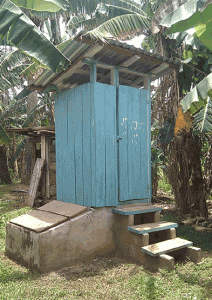
One of MOPAWI’s main project focuses is latrines – common in Central America in areas where there is little sewage infrastructure. Carefully engineered, they prevent disease by containing waste, especially against floods, but they also provide high-fertility compost.
counting the Island states of the world (some of which are threatened with complete eradication from projected Sea-Level Rise), Honduras is considered the state under the 2nd greatest level of threat from the impacts of global warming, due to its fragile coastal ecosystems. Sea level rise and coastal degradation is already pushing salt water into the Mosquitia wetlands, assisted by the effects of deforestation. The end result of this is the destruction of the fish stocks the Misquito live on.
Among its many other projects, MOPAWI have been running conferences to educate people not only about the local causes of environmental degradation and how to mitigate against it, but also their international rights and how to have their voices heard in the global climate change debate. Seeing how the struggle against global climate change was being enacted, through MOPAWI’s work – right there at the sharp edge of it, in one of the most vulnerable and marginalised corners of the world – was both inspiring and humbling. If only the Misquito weren’t so profoundly removed from the politicians and industrialists at the centre of the debates on how to tackle climate change globally…
Conclusion
My visit to the Mosquitia gave me an amazing view of another side of the struggles of indigenous people in Honduras and the wider region. It was really incredible to realise just how diverse a tiny country like Honduras is – the Lenca of COPINH, Garifuna of OFRANEH, and Misquito of MOPAWI couldn’t be more different in terms of their lifestyles, culture, ecosystems and challenges they face. But they are all different indigenous groups, and all of them showed me just how powerful and independent their sense of culture was. One thing they do have in common is that they are all facing extreme marginalisation and poverty, and that none of them are being helped by the Honduran government.
ust like the Zapatista indigenous in Mexico, they are at the edges of development, and seem to have little to gain from it in the form that it is being imposed on them. The Lenca are being criminalised and the Garifuna pushed off their land – their only anchor from the winds of development projects larger than them. The Misquito on the other hand are increasingly finding themselves hit by the impact of the development of the whole world – while contributing nothing to global climate change, it is threatening them with the loss of the freshwater and coastal habitats they rely on.
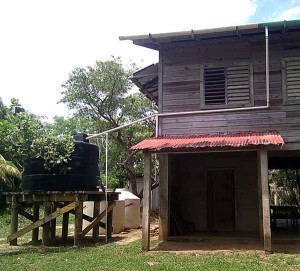
Another priority for MOPAWI is providing drinking water in Misquito communities. They are experimenting with various types of rain water collectors, such as in this picture, where pipes go from the roof of the MOPAWI centre to a tank on the left
Although I don’t have any big answers to these issues, it was inspiring to have the opportunity to see a bit of each of these struggles in Honduras. What it showed me more than anything was just how connected are issues of social justice with those of environmental degradation. This is most apparent in people on the fringes of development, such as indigenous groups who live much closer to their environments, and share the danger when the ecosystem is threatened. Central America is a fascinating place to really see how environmental issues, social issues, cultural diversity and politics come together, and an area that really needs out support.
So, as my travels, and therefore this blog, come to an end (I’ll write one more final instalment to say goodbye, very soon), for anyone who’s been grabbed a little by the issues that I’ve been able to write about here, I would like to suggest keeping up to date with ENCA regularly from now on. We produce our newsletter 3 times a year, and its purpose is to get an even more diverse range of environmental and social news out of Central America and to English-speaking readers. If you want to become a member, for a very small donation we will send you (by email or post) this newsletter as soon as it comes out. By supporting ENCA you will also be able to feel a part of the ongoing, incredible struggles that are being enacted across Central America. ENCA and our partners do really need more support, so please if you’re interested go to our contact page for instructions to sign up.
If not, you can still keep up to date by downloading the newsletter, a little later, from our news page. Whatever you choose, this area of the world really is fascinating, and worth keeping an eye on and a little involved in, that’s all I can say!
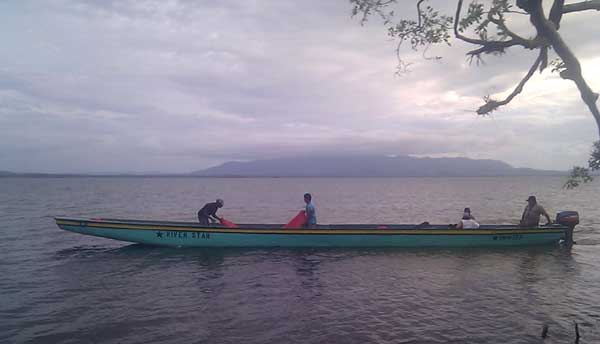
Once you get off the jeep in the Mosquitia, there is no way to progress further but on boats like these motorised canoes
